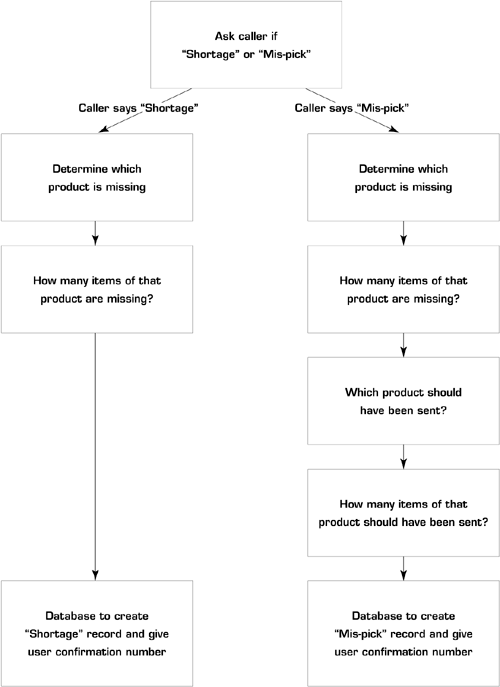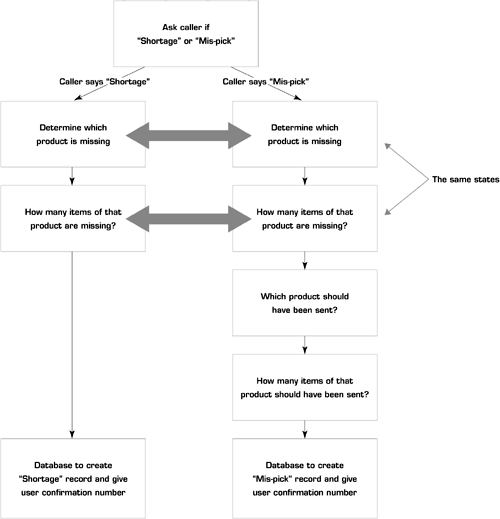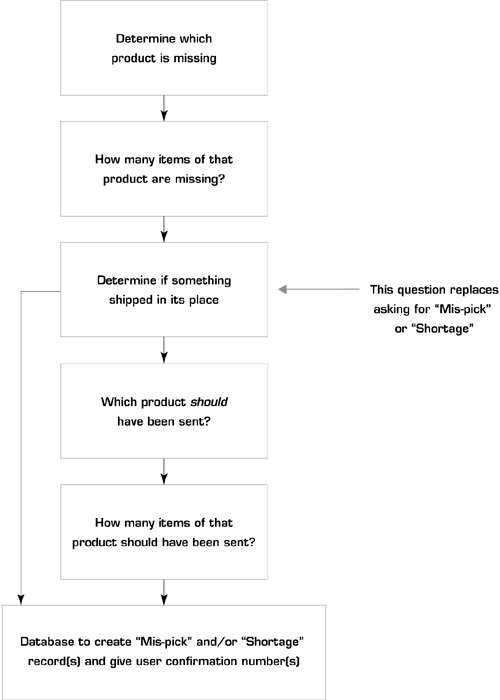Defining the Call Flow
| When the designer has a strong concept and a complete set of ideas with which to express it, the task of designing the call flow can begin. This starts with representing it graphically, then mapping it into a textual form. Call flow simply refers to the structure of the design. This call flow takes callers through a series of states during which they will either be asked to respond to a question, listen to some information, or both. In most applications, the first state is typically called the welcome state, in which the caller is welcomed to the application. At this point, depending on the application, the caller may or may not need to be identified. A home banking application would require the caller's account number, for example, but a purely informational application, such as a voice portal, would not. Using the home banking example, the application would then need to verify the caller's identity by asking for a password or social security number. This usually takes the caller to the equivalent of a main menu ”the starting point from which the caller can move into several states to get account information, transfer funds, set preferences, and so on. When designing the call flow, the objective is to define the structure of the application. This can be as simple as creating a typical flowchart diagram. However, because the call flow and the prompt text are closely linked, it's often helpful to include notes describing how certain complex situations will be handled. The actual writing of the prompt text will come later. Figure 5.1 illustrates a rudimentary call flow diagram, designed to show only the big picture of how people will move through the various states in the application. Figure 5.1. A Call Flow Diagram Although the call flow diagram is a depiction of the structure of an application, it can also be used to convey design ideas and to help the designer think about various solutions. In my diagrams, I may not even draw all the arrows or include all the boxes if I need to describe a complex situation and I haven't quite worked out all the details. Instead, I might just draw some gray arrows and write a note to the reader describing the behavior that should logically follow, and flesh out the details later when I've gained more information or after I've had the opportunity to review the design. A Real-World Example of a Call FlowLet's explore the different ways to structure a call flow using a real example. I once designed a system for a large wholesale distributor that allowed its retail customers to call in and report two kinds of shipping errors. The client wanted the system to handle these errors and catalogue them appropriately. This company shipped products to its retailers almost every day. Its speech-recognition application enabled retail staff (usually stock clerks) to report shipping errors and receive a credit toward their next shipment. The two types of shipping errors that could occur were
How might a designer create a call flow to handle this? The most common way that I've seen people design the solution looks like the one in Figure 5.2. Figure 5.2. A Common Call Flow Solution Although this approach would work, there are better ways to do it ”if we first consider a few relevant factors. First, we need to understand the callers who would use the system. In this example, they were most often stock clerks ”low-paid, entry-level workers with little interest or incentive to learn the manufacturer's jargon and processes. Instead, I opted for a way to handle the situation without requiring callers to answer questions like "Was there a shortage or a mis-pick?" When we examine Figure 5.3, we can see overlaps and similarities in the structure. Figure 5.3. Comparison of the Structure of the Call Flow Diagrams Figure 5.4 shows how you can streamline the design and modify the approach by simplifying the questions for callers. Figure 5.4. Simplified Call Flow Solution Often when I present this example, people ask me how it can handle the reporting of shortages and mis-picks to appropriate databases if they are collapsed from two states into one. This is an instance where a good programmer will decide how best to devise a reporting mechanism for this interface without compromising the design. The designer's objective and responsibility are to ensure the most elegant call flow, not to force the programmer to structure things in any particular way. In this example, the programmer could decide either to
Either way, it's the programmer's decision ”not the designer's. The Top Five Tenets of Call Flow Diagram Design
|
EAN: 2147483647
Pages: 105



